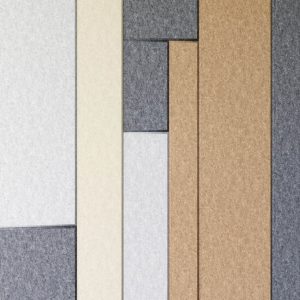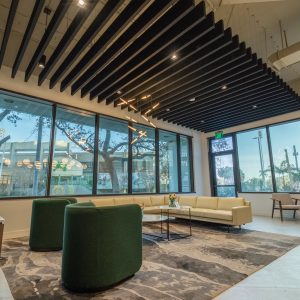No one likes overly loud rooms. They make communication difficult and may contribute to mental and physical problems for everyone who spends too much time in them. Every type of indoor space can experience noise issues, from small offices to large halls, so it’s important that we mitigate them through a combination of modern materials and thoughtful design.
Room noise can often be attributed to a combination of acoustic problems like echo and reverberation and poor insulation. MATERIAL LOGIQ carries high-performance acoustic materials that blend aesthetics and functionality, and we have an experienced staff ready to help you use them to quiet your noisiest spaces. Here’s how we develop acoustical treatment plans that work.
Understanding Acoustic Problems Through Material and Design
There are a number of factors that contribute to the noise issues we deal with in our indoor spaces. Modern building design and the materials that go into the construction of home and office spaces are directly responsible for some of the noise issues we face every day. We must consider them in order to put an effective plan together.
Echo and Reverberation in Reflective Spaces
Let’s begin with echo and reverberation, which are leading causes of noise in indoor spaces. When sound waves reflect off of hard, smooth surfaces such as glass, concrete, or metal, they bounce back into the space and create an echo. If there is nothing to absorb echoes, they will build up and the room may become reverberant to the point where ambient noise becomes very apparent. This can create issues with communication and speech intelligibility, and can reduce sound quality in general.
We reduce echo and reverberation in reflective spaces through the introduction of sound-absorbing materials. These materials effectively control acoustic problems by absorbing sound waves and reducing reflections. Some of the most popular options include acoustic panels, ceiling systems, and perforated wood panels.
Sound Leakage Through Weak Barriers
Another weak point in modern construction is the strength of the barriers. Standard lightweight drywall partitions, hollow-core doors, and aging windows create significant acoustic vulnerabilities. Sound waves easily penetrate these barriers, particularly at lower frequencies. Effective sound blocking requires addressing these weak points with increased mass, proper gasketing and seals, and potentially utilizing decoupled construction techniques – improvements that provide measurable increases in Sound Transmission Class (STC) ratings and noticeably quieter spaces.
Vibrational Noise in Structural Design
Even with somewhat structurally sound barriers, vibrational noise may find ways to pass through and become a nuisance. In order to prevent this vibrational noise from reaching our ears, we use soundproofing materials to add mass and density, decouple surfaces, and convert vibrational energy into heat energy. Vibrational noise control is an incredibly important part of keeping interior noise in and exterior noise out.
Key Acoustic Materials for Fixing Problems
We have looked at some of the common acoustical issues we experience in indoor spaces, as well as how different materials can be used to tackle them.
Now, we will look at some of the best options in each category for managing noise effectively.
Absorptive Materials for Controlling Sound
Absorptive materials are intended to absorb sound waves and reduce reflections. There are a number of different options out there, and depending on your needs, some will work better than others. Here are some of the most popular options on the market.
Fabric-Wrapped Acoustic Panels
A mainstay in the world of acoustical treatment is the fabric-wrapped acoustic panel. These aesthetic acoustic solutions are constructed with absorbent cores that are wrapped with an acoustically-transparent fabric, allowing sound waves to pass into the core and become trapped. They may be mounted to walls to reduce reflections or suspended as acoustic baffles for ceilings to catch reflections as they traverse space.
The fabric is available in a wide range of colors, and can even be custom-printed, meaning this is an attractive solution that’s appropriate for even high-end spaces. They represent a beautiful combination of aesthetics and functionality that you can’t get in every material option.
Recycled Polyester Panels
For those who want eco-friendly materials for their acoustic treatments, recycled acoustic products like polyester panels are a great choice. PET plastic, or Polyethylene Terephthalate, is made primarily from recycled plastic bottles and is highly effective at absorbing sound waves. These sustainable acoustic panels are available in a range of colors, sizes, and textures, so they are an aesthetically pleasing option that can stand up well to moisture, fungus, and pests.
Green Solutions
If you are looking to incorporate more green building materials for a more biophilic design, you can use natural materials to help absorb sound. The inclusion of certain plants, such as moss on walls or a few ficus plants scattered about, can help absorb and diffuse sound waves in your noisy spaces. They both help connect us to nature and provide a moderate level of sound control.
Sound-Blocking Materials for Privacy
For dealing with exterior noise, soundproofing materials are necessary to block sound passage. The most important steps include adding mass and density to walls, ceilings, and floors, and upgrading to soundproof doors and windows.
Dense Materials like Mass Loaded Vinyl
One of the main objectives when soundproofing walls, ceilings, and floors is to add mass and density to the barrier. There are a number of material options available for accomplishing this, but one of the most versatile is Mass Loaded Vinyl. It can easily be rolled out between studs and drywall (or between sheets of drywall if you want extra stopping power) to add mass and density to walls and ceilings. It can even be used between the subfloor and top flooring material to soften footfalls and prevent sound passage between floors.
Acoustic Glass
Old windows are not great at blocking sound. If yours are ready to be replaced, acoustic glass with multiple panes and special coatings in your windows can block a tremendous amount of sound. As an added benefit, these windows are incredibly energy efficient, meaning your energy bills may go down enough to cover the cost of the new windows over time.
Soundproof Insulation
The spaces between studs and walls can amplify sound and create issues with sound leakage. Unfortunately, traditional insulation won’t do much to help. Soundproof insulation, also called high-performance acoustic insulation, is made from materials that are engineered to absorb sound waves and prevent their movement through walls, floors and ceilings. There are multiple different material variations, and some can even be installed without any special tools or knowledge.
Acoustic Doors
Doors are a common place to experience sound leakage. Many doors simply are not thick enough or heavy enough to block sound, and even if they are, many have gaps around the frame that allow sound to pass through. Acoustic doors are a professional solution to this problem. Heavyweight doors with door seal kits are substantial enough to block the majority of sound on either side from passing through.
Diffusive Materials for Balanced Sound
When we want a natural, pleasant sounding space, diffusive materials are necessary. They are often sold as wooden slats, geometric diffusers, and decorative wall diffusers, and they help scatter sound evenly across spaces, improving sound quality significantly. This is especially necessary in music studios, theaters, and auditoriums, but even our favorite spaces around our homes can benefit from the addition of sound diffusers for a more pleasant atmosphere.
Multi-Functional Acoustic Solutions
Many acoustical treatment solutions are mounted to our walls and ceilings, but others can serve as noise-reducing construction materials. Modular acoustic tiles can be dropped into existing drop ceiling T-grid systems for an acoustic ceiling, while perforated metal panels are a high-end option for walls and ceilings.
Steps for Designing Acoustically Sound Spaces
For most of us, working with professionals will help us get the best performance out of our acoustic treatments. If we aren’t familiar with the laws of acoustics, it can be difficult to identify which products we need and how to best utilize them in our unique spaces.
MATERIAL LOGIQ has the professional products and expert staff to help you make the most out of your project.
1) Collaborating with Architects to Identify Needs
MATERIAL LOGIQ works with architects to evaluate project requirements and identify acoustic challenges early in the design phase. Acoustic consulting for architects helps property owners design spaces with acoustical performance in mind.
2) Custom Acoustic Solutions for Every Project
MATERIAL LOGIQ provides tailored solutions, including custom acoustic materials, that meet specific architectural and aesthetic needs. If you have a unique project that requires special needs, reach out to see how we can help.
3) Balancing Aesthetics and Functionality
Using the proper materials can enhance the visual appeal of a space while addressing acoustical problems. There are a wide array of decorative acoustic treatments that combine form and function in wonderful ways.
Why Material Selection Matters for Long-Term Acoustic Success
There are numerous DIY acoustic panel projects floating around the internet. Some will work okay, and most will look very homemade. If you want a product that looks great, offers effective performance, and will last for years to come, professional materials are a necessity.
Durability and Performance of Acoustic Materials
Investing in premium acoustic materials ensures long-term performance, reducing the need for frequent replacement or repairs.
Whether you need durable soundproofing materials that are resistant to moisture and pests, are Class A fire rated, or that simply look great, there are professional acoustic options that will perform exquisitely and last for many years without fading or sagging the way DIY projects often do.
Sustainable and Eco-Friendly Acoustic Options
MATERIAL LOGIQ has a commitment to the health of our planet, and carries a wide variety of eco-friendly options that solve acoustic problems without putting undue strain on our supply of resources. If you are focusing on noise-canceling building designs that may help your project qualify for LEED credits, reach out to MATERIAL LOGIQ to learn about our eco-friendly architectural acoustic solutions.




